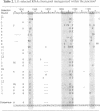Abstract
Ribosomal protein L11 and an antibiotic, thiostrepton, bind to the same highly conserved region of large subunit ribosomal RNA and stabilize a set of NH4(+)-dependent tertiary interactions within the domain. In vitro selection from partially randomized pools of RNA sequences has been used to ask what aspects of RNA structure are recognized by the ligands. L11-selected RNAs showed little sequence variation over the entire 70 nucleotide randomized region, while thiostrepton required a slightly smaller 58 nucleotide domain. All the selected mutations preserved or stabilized the known secondary and tertiary structure of the RNA. L11-selected RNAs from a pool mutagenized only around a junction structure yielded a very different consensus sequence, in which the RNA tertiary structure was substantially destabilized and L11 binding was no longer dependent on NH4+. We propose that L11 can bind the RNA in two different 'modes', depending on the presence or absence of the NH4(+)-dependent tertiary structure, while thiostrepton can only recognize the RNA tertiary structure. The different RNA recognition mechanisms for the two ligands may be relevant to their different effects on protein synthesis.
Full text
PDF







Images in this article
Selected References
These references are in PubMed. This may not be the complete list of references from this article.
- Bartel D. P., Zapp M. L., Green M. R., Szostak J. W. HIV-1 Rev regulation involves recognition of non-Watson-Crick base pairs in viral RNA. Cell. 1991 Nov 1;67(3):529–536. doi: 10.1016/0092-8674(91)90527-6. [DOI] [PubMed] [Google Scholar]
- Draper D. E., Xing Y., Laing L. G. Thermodynamics of RNA unfolding: stabilization of a ribosomal RNA tertiary structure by thiostrepton and ammonium ion. J Mol Biol. 1995 Jun 2;249(2):231–238. doi: 10.1006/jmbi.1995.0291. [DOI] [PubMed] [Google Scholar]
- Egebjerg J., Douthwaite S. R., Liljas A., Garrett R. A. Characterization of the binding sites of protein L11 and the L10.(L12)4 pentameric complex in the GTPase domain of 23 S ribosomal RNA from Escherichia coli. J Mol Biol. 1990 May 20;213(2):275–288. doi: 10.1016/S0022-2836(05)80190-1. [DOI] [PubMed] [Google Scholar]
- Gutell R. R., Schnare M. N., Gray M. W. A compilation of large subunit (23S- and 23S-like) ribosomal RNA structures. Nucleic Acids Res. 1992 May 11;20 (Suppl):2095–2109. doi: 10.1093/nar/20.suppl.2095. [DOI] [PMC free article] [PubMed] [Google Scholar]
- Heus H. A., Pardi A. Structural features that give rise to the unusual stability of RNA hairpins containing GNRA loops. Science. 1991 Jul 12;253(5016):191–194. doi: 10.1126/science.1712983. [DOI] [PubMed] [Google Scholar]
- Kooi E. A., Rutgers C. A., Mulder A., Van't Riet J., Venema J., Raué H. A. The phylogenetically conserved doublet tertiary interaction in domain III of the large subunit rRNA is crucial for ribosomal protein binding. Proc Natl Acad Sci U S A. 1993 Jan 1;90(1):213–216. doi: 10.1073/pnas.90.1.213. [DOI] [PMC free article] [PubMed] [Google Scholar]
- Laing L. G., Draper D. E. Thermodynamics of RNA folding in a conserved ribosomal RNA domain. J Mol Biol. 1994 Apr 15;237(5):560–576. doi: 10.1006/jmbi.1994.1255. [DOI] [PubMed] [Google Scholar]
- Lu M., Draper D. E. Bases defining an ammonium and magnesium ion-dependent tertiary structure within the large subunit ribosomal RNA. J Mol Biol. 1994 Dec 16;244(5):572–585. doi: 10.1006/jmbi.1994.1753. [DOI] [PubMed] [Google Scholar]
- Perret V., Florentz C., Puglisi J. D., Giegé R. Effect of conformational features on the aminoacylation of tRNAs and consequences on the permutation of tRNA specificities. J Mol Biol. 1992 Jul 20;226(2):323–333. doi: 10.1016/0022-2836(92)90950-o. [DOI] [PubMed] [Google Scholar]
- Puglisi J. D., Pütz J., Florentz C., Giegé R. Influence of tRNA tertiary structure and stability on aminoacylation by yeast aspartyl-tRNA synthetase. Nucleic Acids Res. 1993 Jan 11;21(1):41–49. doi: 10.1093/nar/21.1.41. [DOI] [PMC free article] [PubMed] [Google Scholar]
- Rosendahl G., Douthwaite S. The antibiotics micrococcin and thiostrepton interact directly with 23S rRNA nucleotides 1067A and 1095A. Nucleic Acids Res. 1994 Feb 11;22(3):357–363. doi: 10.1093/nar/22.3.357. [DOI] [PMC free article] [PubMed] [Google Scholar]
- Ryan P. C., Draper D. E. Detection of a key tertiary interaction in the highly conserved GTPase center of large subunit ribosomal RNA. Proc Natl Acad Sci U S A. 1991 Jul 15;88(14):6308–6312. doi: 10.1073/pnas.88.14.6308. [DOI] [PMC free article] [PubMed] [Google Scholar]
- Ryan P. C., Draper D. E. Thermodynamics of protein-RNA recognition in a highly conserved region of the large-subunit ribosomal RNA. Biochemistry. 1989 Dec 26;28(26):9949–9956. doi: 10.1021/bi00452a012. [DOI] [PubMed] [Google Scholar]
- Ryan P. C., Lu M., Draper D. E. Recognition of the highly conserved GTPase center of 23 S ribosomal RNA by ribosomal protein L11 and the antibiotic thiostrepton. J Mol Biol. 1991 Oct 20;221(4):1257–1268. doi: 10.1016/0022-2836(91)90932-v. [DOI] [PubMed] [Google Scholar]
- Sampson J. R., DiRenzo A. B., Behlen L. S., Uhlenbeck O. C. Role of the tertiary nucleotides in the interaction of yeast phenylalanine tRNA with its cognate synthetase. Biochemistry. 1990 Mar 13;29(10):2523–2532. doi: 10.1021/bi00462a014. [DOI] [PubMed] [Google Scholar]
- Tang C. K., Draper D. E. Unusual mRNA pseudoknot structure is recognized by a protein translational repressor. Cell. 1989 May 19;57(4):531–536. doi: 10.1016/0092-8674(89)90123-2. [DOI] [PubMed] [Google Scholar]
- Thompson J., Cundliffe E. The binding of thiostrepton to 23S ribosomal RNA. Biochimie. 1991 Jul-Aug;73(7-8):1131–1135. doi: 10.1016/0300-9084(91)90156-u. [DOI] [PubMed] [Google Scholar]
- Turner D. H., Sugimoto N., Freier S. M. RNA structure prediction. Annu Rev Biophys Biophys Chem. 1988;17:167–192. doi: 10.1146/annurev.bb.17.060188.001123. [DOI] [PubMed] [Google Scholar]
- Wang Y. X., Lu M., Draper D. E. Specific ammonium ion requirement for functional ribosomal RNA tertiary structure. Biochemistry. 1993 Nov 23;32(46):12279–12282. doi: 10.1021/bi00097a002. [DOI] [PubMed] [Google Scholar]
- Xing Y., Draper D. E. Stabilization of a ribosomal RNA tertiary structure by ribosomal protein L11. J Mol Biol. 1995 Jun 2;249(2):319–331. doi: 10.1006/jmbi.1995.0299. [DOI] [PubMed] [Google Scholar]
- Zengel J. M., Lindahl L. Domain I of 23S rRNA competes with a paused transcription complex for ribosomal protein L4 of Escherichia coli. Nucleic Acids Res. 1993 May 25;21(10):2429–2435. doi: 10.1093/nar/21.10.2429. [DOI] [PMC free article] [PubMed] [Google Scholar]




